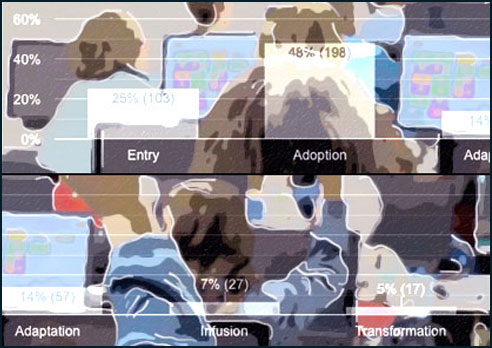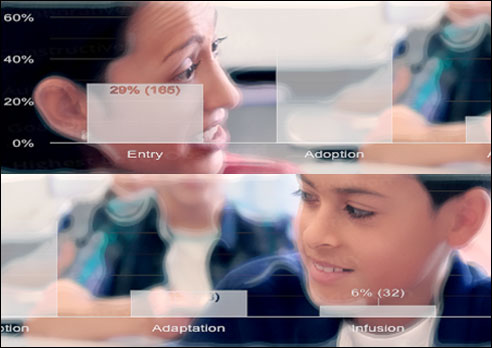Technology Integration Matrix Lesson Observation Tool (TIM-O)
 The TIM-O is a flexible tool for observing face-to-face or virtual lessons. It can be used for formative feedback, peer coaching, grant evaluation, or professional development planning. The TIM-O is a web-based system that works on any device and requires no software installation. It is especially convenient to use on a tablet computer or smart phone if you are observing a face-to-face lesson. The TIM Observation Tool is designed to guide principals, teachers, and others through the process of evaluating the level of technology integration within a particular lesson. When completed, the tool produces a profile for the observed lesson in terms of the Technology Integration Matrix.
The TIM-O is a flexible tool for observing face-to-face or virtual lessons. It can be used for formative feedback, peer coaching, grant evaluation, or professional development planning. The TIM-O is a web-based system that works on any device and requires no software installation. It is especially convenient to use on a tablet computer or smart phone if you are observing a face-to-face lesson. The TIM Observation Tool is designed to guide principals, teachers, and others through the process of evaluating the level of technology integration within a particular lesson. When completed, the tool produces a profile for the observed lesson in terms of the Technology Integration Matrix.
The TIM-O provides a branching series of questions that helps to provide consistent results regardless of observer familiarity with technology integration. Skip-logic in the series of questions greatly increases the efficiency of the observation. Because classrooms, learning management systems, and other instructional settings are varied and complex, the tool allows the evaluator to adjust the identified levels based on careful consideration of the observation as a whole.
 This lesson observation tool is based on the Technology Integration Matrix (TIM) developed by FCIT. If you are not familiar with the TIM, you should begin an observation with the question-based option. We recommend that you observe a face-to-face or online synchronous lesson for five to ten minutes before answering any questions. If you are observing an asynchronous lesson, you should be able to begin answering questions immediately since you have access to every aspect of the lesson upfront. The question-based option is designed to arrive at a profile in a minimum number of steps. The total number of questions asked will vary depending on how you answer earlier questions.
This lesson observation tool is based on the Technology Integration Matrix (TIM) developed by FCIT. If you are not familiar with the TIM, you should begin an observation with the question-based option. We recommend that you observe a face-to-face or online synchronous lesson for five to ten minutes before answering any questions. If you are observing an asynchronous lesson, you should be able to begin answering questions immediately since you have access to every aspect of the lesson upfront. The question-based option is designed to arrive at a profile in a minimum number of steps. The total number of questions asked will vary depending on how you answer earlier questions.
If you are very familiar with the Technology Integration Matrix and are comfortable with the observation protocol, you may choose to evaluate the levels of technology integration directly using the Matrix-based option. An observer who knows the TIM well will find the Matrix-based version somewhat faster to use. We strongly recommend, however, the use of the question-based version for observers who are less familiar with the TIM in order to avoid subjective interpretation.
The TIM-O provides a space for the observer to take personal notes or work on draft comments. Personal notes and drafts do not become part of the observation record unless copied into the report comments field by he observer. Hyperlinks to other documents such as the teacher’s lesson plan, lesson materials, annotated screenshots of the LMS, or photographs can also be added to an observation. The observer can preview the observation before electing to submit it to the system. The observer can also email the teacher directly from the TIM-O or download a PDF of the observation.
Lesson Plan Review Tool (TIM-LP)
This tool is designed to guide principals, teachers, and others through the process of evaluating the level of technology integration within a particular lesson plan. When completed, the tool indicates a profile for the reviewed lesson plan in terms of the Technology Integration Matrix. With multiple lesson plan reviews, the TIM-LP helps evaluators get a clear picture of the professional development needs of the lesson plans to support further technology integration. Reviewing lesson plans rather than the lesson itself is particularly useful both in project evaluation when a large number of data points is required or in cases where a teachers are using a wide variety of tools in the course of online instruction and it would not be practical for the observer to log into the various systems being used.
Reflection Tool (TIM-R)
 This tool is designed to guide a teacher through the process of evaluating the level of technology integration within a particular lesson. When completed, the tool indicates a profile for the lesson in terms of the Technology Integration Matrix. With multiple reflections, the TIM-R helps teachers get a clear picture of their professional development needs to support further technology integration. If a school or district has suddenly moved to online instruction and does not have available staff to observe the variety of online instruction methods being used, asking teachers to complete a TIM-R reflection on a regular basis is a convenient way to gain insight into what is happening in online instruction and to identify the sorts of professional development or coaching supports that will be most effective.
This tool is designed to guide a teacher through the process of evaluating the level of technology integration within a particular lesson. When completed, the tool indicates a profile for the lesson in terms of the Technology Integration Matrix. With multiple reflections, the TIM-R helps teachers get a clear picture of their professional development needs to support further technology integration. If a school or district has suddenly moved to online instruction and does not have available staff to observe the variety of online instruction methods being used, asking teachers to complete a TIM-R reflection on a regular basis is a convenient way to gain insight into what is happening in online instruction and to identify the sorts of professional development or coaching supports that will be most effective.
The TIM-LP and TIM-R variations of the TIM-O were added to the TIM Tools suite at the request of client districts. Many districts were using the TIM-O as a tool for teachers to reflect upon their own lesson in addition to an observation tool. They found this to be a very valuable exercise for teachers, but in earlier versions of TIM Tools, doing so required making every teacher in the district an observer so that they could observe themselves. Other districts were using the TIM-O to review lesson plans, especially as a part of a grant evaluation project. Both uses, however, resulted in a TIM-O database where teacher reflections, observations, and lesson plan reviews were intermixed. By separating out the TIM-R and the TIM-LP, districts can now use versions of the TIM-O for teacher lesson reflection or for lesson plan review and not have reflection and lesson plan data intermixed with actual observation data when they generate reports. The various versions of the TIM-O can be used in conjunction with each other. For example, an observer might request that teachers to complete a TIM-R reflection on the same lessons in which they were observed. The observation profile and comments can be compared with the reflection profile and comments in a follow-up conference as a starting point for a conversation about the lesson.

Figure 1: Beginning a new classroom technology observation. The observer selects either the question-based or matrix-based method and then selects the school and teacher’s name from dropdown menus.
NOTE: Your district’s name will appear in the banner on each page where you see the words “Anytowne Public Schools” in the screenshots.
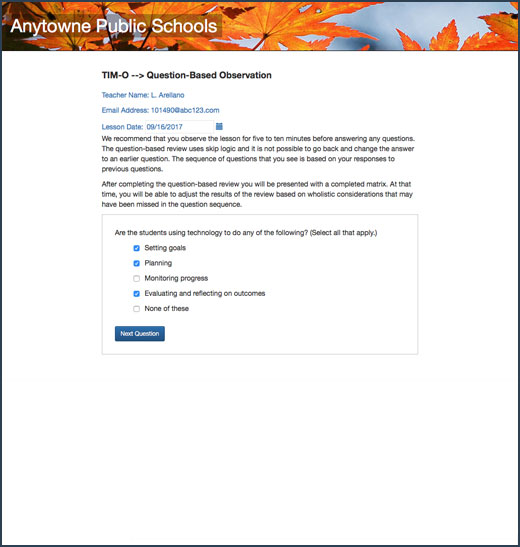
Figure 2: A question-based observation. The observer answers a series of branching questions that use skip-logic to quickly determine the TIM profile for the observed lesson. Questions are either true/false or multiple choice, but all are based on observable behavior during the lesson.
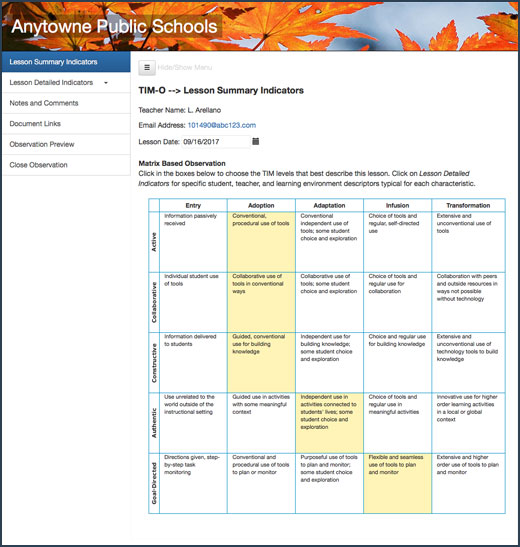
Figure 3: A TIM profile. Observers who chose the matrix-based method will be taken directly to a blank matrix where each cell is selectable to build a TIM lesson profile. Observers who chose the question-based method will be taken to a completed matrix profile when they finish the series of questions. Observers using either method can then adjust the profile, add comments, insert links to additional documents and other supporting artifacts, and then submit the observation whenever they are ready.
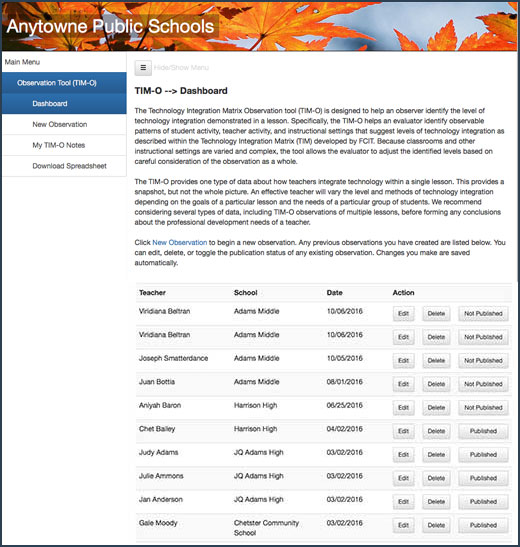
Figure 4: The TIM-O dashboard. Observers can access all of their previous classroom technology observations, provide additional edits, delete, or publish the observation to the system whenever they are satisfied with the lesson profile and their comments.
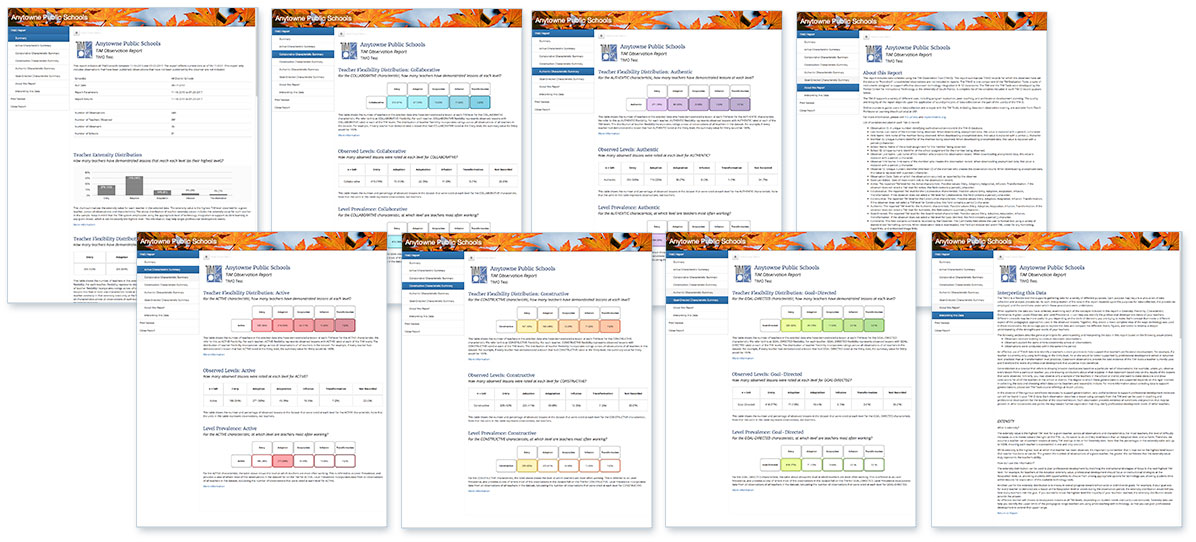
Figure 5. A district summary report output as a series of webpages.

Figure 6. A district summary report output for printing. Reports formatted for print can also be saved as a PDF.
The TIM-O, TIM-R, TIM-LP, TIM-C, TUPS, ARTI, and the Survey Tool are all managed from a central Admin Center. Subscription rates for the TIM Tools suite include the TIM-O and all other tools.
Give us a call at 813-974-9979 or email TIM@fcit.us. We are happy to answer any questions you have or to schedule a time to discuss how your school or district can use the TIM-O for formative feedback, peer coaching, grant evaluation, or professional development planning. The TIM Tools suite provides a convenient solution for schools that have moved to online or blended instruction, but were previously accustomed to providing oversight, support, and coaching just by “walking around.” The types of interactions that were formerly handled in person can be continued online using tools such as the TIM-O and the TIM-C.
Detailed information about managing the TIM-O, TIM-LP, and TIM-R can be found in the TIM Tools Administration Guide. Additional information about the TIM-O, TIM-R, and TIM-LP can be found on the TIM-O FAQs section and in the following posts:
How many observations do I need?
Here’s a great question I recently received: In your experience, what are the optimal numbers of TIM Lesson Plan (TIM-LP) reviews per teacher and TIM Observations (TIM-O) per teacher to get actionable data? This is an interesting question and there is no….
Ten Tips for TIM-O Observers
Classroom observations are a key component of any professional development program. Having a good observation instrument helps, but no observation instrument is of much value unless used well by the observer. Whether you are an administrator, coach, or peer teacher…
Extensity: A Teacher’s Highest Integration Level
This month we will begin a new series entitled “Getting the most from your TIM Observation Data.” A careful consideration of your TIM-O data will give you a deeper understanding of the technology-related strengths and needs of your teachers so you can more….
Highest Levels Observed
Second in a series on getting the most from your TIM-O data, Dr. Harmes explains how the “highest levels observed” data gives you a more complete picture of what is typically occurring in classrooms in your school or district with regard to levels of technology integration.
Flexibility: A Teacher’s Range of Technology Integration Levels
Flexibility refers to a teacher’s ability to deliver a lesson at each TIM level for each characteristic of meaningful learning. This provides a view of the range within which your teachers have been observed delivering technology-infused lessons.
Level Prevalence: A Snapshot of Typical Teacher Classroom Technology Use
Level Prevalence identifies the most frequently occurring TIM level for each characteristic of meaningful learning. Level Prevalence as a view of typical classroom use across a set of lesson observations can help us answer the question for each TIM characteristic, “At what level are teachers most often delivering lessons?”
Start with a Reflection
We frequently consult with school districts that have recently licensed TIM Tools. Generally, we suggest that they start by administering the Technology Uses and Perceptions Survey (TUPS) to collect baseline data. This is especially important for districts that are….
Want To Know More?
Schedule a personal walk-through of the TIM Tools for yourself or your staff. See how this flexible set of technology integration tools will meet your school or district's specific needs.
Get an Instant TIM Tools Quote!
Use our no-obligation quote generator to create an instant TIM Tools license quote you can submit to your school or district's purchasing department.



